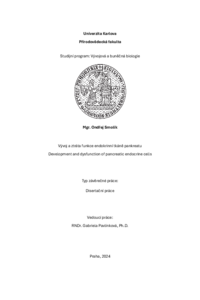Vývoj a ztráta funkce endokrinní tkáně pankreatu
Development and dysfunction of pancreatic endocrine cells
rigorous thesis (RECOGNIZED)

View/Open
Permanent link
http://hdl.handle.net/20.500.11956/197610Identifiers
Study Information System: 281596
Collections
- Kvalifikační práce [20363]
Author
Faculty / Institute
Faculty of Science
Discipline
Reproduction and Developmental Biology
Department
Department of Cell Biology
Date of defense
12. 3. 2025
Publisher
Univerzita Karlova, Přírodovědecká fakultaLanguage
Czech
Grade
Recognized
Keywords (Czech)
myší model, transkripční regulace, RNA-seq, single cell analýza, diabetes, Neurod1, Islet1Keywords (English)
mouse model, transcriptional regulation, Neurod1, Islet1, diabetes, islets, RNA-seq, single cell analysisIncidence diabetu dlouhodobě světově roste a hledání nových terapeutických přístupů narůstá na významu. Cílem je nalezení funkční náhrady za dysfunkční pankreatickou endokrinní tkáň, konkrétně beta buňky produkující inzulín. Významný potenciál se nachází v reprogramování příbuzných buněčných typů, které vzájemně sdílí blízké vývojové progenitory. Znalost transkripčně regulačních sítí řídících proces endokrinní specifikace a diferenciace by mohla vést v budoucnu k cílené buněčné terapii in situ či in vitro. Endokrinní linie je ve vyvíjejícím se pankreatu specifikována expresí Neurog3, který iniciuje komplexní kaskádu reorganizace chromatinu a kaskádovitou časově specifickou expresi genů vedoucí ke vzniku všech endokrinních buněčných typů z multipotentních progenitorů. Role mnoha těchto genů však není dosud objasněna. Tato dizertační práce se soustředí na NEUROD1 a ISL1, dva klíčové transkripční faktory nezbytné pro endokrinní vývoj a funkci. Oba faktory indukují během vývoje specifické diferenciační programy v jiných buněčných typech, kde reorganizují chromatin. Pomocí pokročilé analýzy fenotypu tkáňově specifických delecí těchto faktorů v myším modelu, molekulárně genetických přístupů (RT-qPCR, RNA-seq) a epigenomického profilování (CUT&Tag-seq) se podařilo identifikovat vliv těchto faktorů na časnou diferenciaci,...
The global incidence of diabetes has been steadily increasing, highlighting the urgent need for innovative therapeutic strategies. One promising approach is to develop functional replacements for dysfunctional pancreatic endocrine tissue, particularly insulin-producing beta cells. Reprogramming related cell types that share common developmental progenitors holds significant potential. A deeper understanding of the transcriptional regulatory networks that govern endocrine specification and di@erentiation could pave the way for targeted cell therapies, both in situ and in vitro. In the developing pancreas, the endocrine lineage is specified by the expression of Neurog3, which triggers a complex cascade of chromatin reorganization and temporally specific gene expression, leading to the formation of all endocrine cell types from multipotent progenitors. However, the roles of many of these genes remain unclear. This dissertation focuses on NEUROD1 and ISL1, two critical transcription factors essential for endocrine development and function. These factors induce specific di@erentiation programs in other non-pancreatic cell types during development, reorganizing chromatin in the process. Through advanced phenotypic analysis of tissue-specific deletions of these factors in a mouse model, along with molecular genetic...
